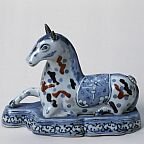Japan
dal 8/7/2007 al 19/1/2008
Segnalato da
8/7/2007
Japan
Groninger Museum, Groningen
Ceramics exhibition

Ceramics exhibition
Exhibition co-ordinators Caspar Martens, Susan Groot, assistant curator for Asian ceramics
Exhibition layout Mark Wilson
From today onward, until 20 January 2008, the Starck Pavilion of the Groninger Museum will present the ceramics exhibition entitled Japan. This exhibition is the sixth in the framework of a co-operative venture initiated by the Rijks Museum Amsterdam, the Gemeente Museum of The Hague, the Princessehof Museum of Ceramics in Leeuwarden, and the Groninger Museum. Every year, a part of their joint collection is shown in one of these museums. This exhibition displays exceptional objects from the collection of Japanese porcelain belonging to the Jan Menze van Diepen Foundation. (Fraeyelemaborg, Slochteren)
Although arising later than in China, Japan also has a long tradition of porcelain production. International trade in this commodity began in around 1600, stimulated by the arrival in Japan of the Verenigde Oost-Indische Compagnie, VOC (Dutch East India Company) which established a colony on the island of Deshima, off the coast of Nagasaki. At that time, China was plagued by civil war in which the porcelain kilns in Jingdezhen were largely destroyed. In order to meet the great demand for porcelain in the West, the VOC sought an area where potters were capable of matching the quality of Chinese porcelain. The VOC turned its attention to Japan, not only because of its strategic position and the presence of skilled ceramists, but also because it possessed the necessary raw materials to create high-quality porcelain.
Production for the Japanese domestic market ran parallel to production oriented toward export to other Asian countries and to the West. Shapes and decorations were adapted to the demand and tastes of the various consumer markets. For example, blue underglaze was popular among Europeans due to its exotic allure. The colourful Imari porcelain appeared a little later and this harmonized ideally with the then-fashionable baroque European interiors. The consumption of tea and coffee became extremely popular in Europe in the 17th century, inspiring the demand for cups and saucers and resulting in an explosive increase in Japanese porcelain production.
In addition to this large group of objects that were specially manufactured for the European market, the exhibition also shows countless items that were intended for the Japanese and inter-Asian trade. The impulse for this exhibition was the substantial collection of Japanese porcelain that Prof. Dr. Christiaan Jörg published in the review catalogue entitled Fine & Curious: Japanese Export Porcelain in Dutch Collections in 2003.
Groninger Museum
Museumeiland 1 - Groninger



